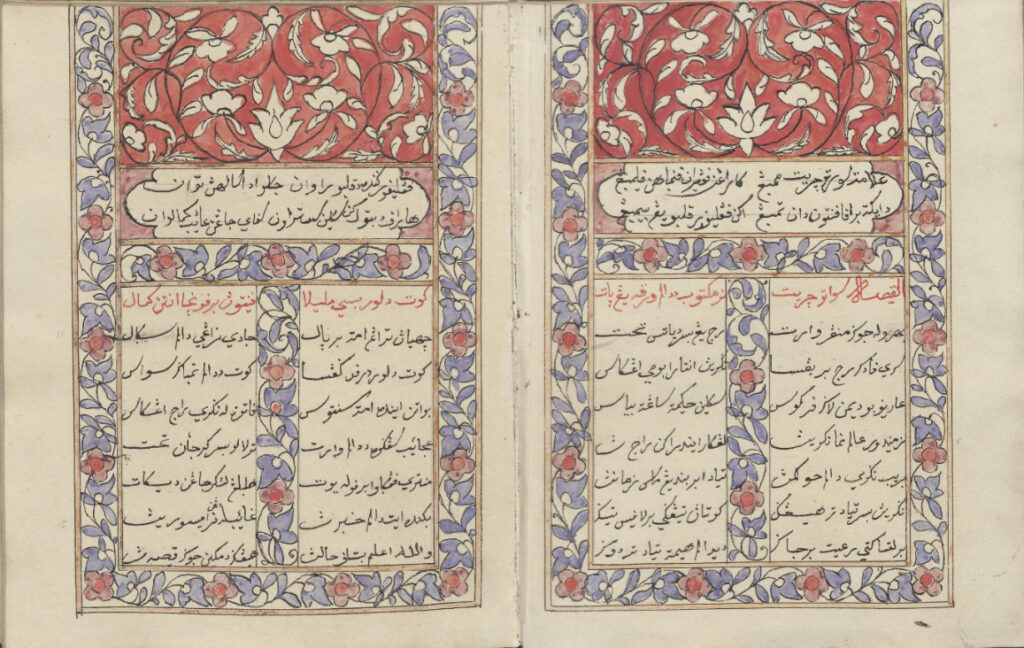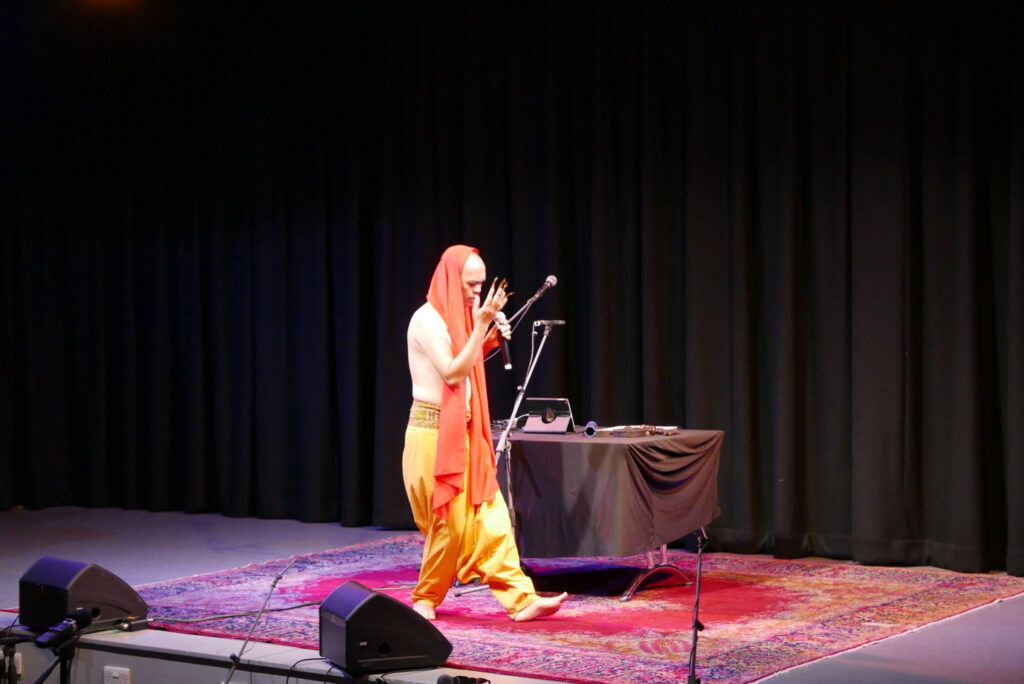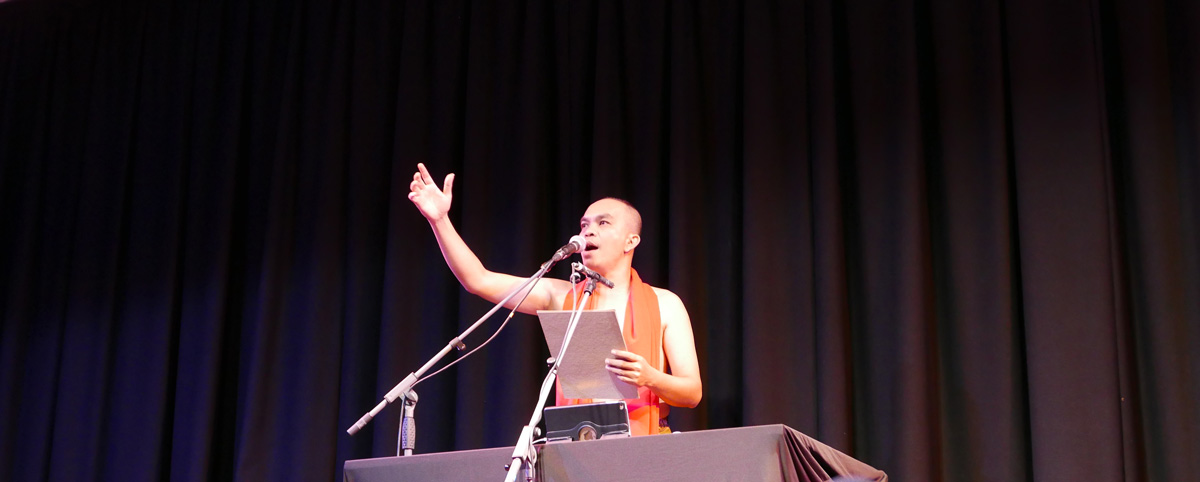Leva’s performance of the recitation of Syair Raja Mambang Jauhari with musical accompaniment combined with music, dance, and body percussion.
“Zamnidur Alam”: Reanimating Syair Raja Mambang Jauhari
by Alan Darmawan
Leva Khudri Balti, a performance artist based in Riau, Indonesia, recited the opening quatrains of the narrative poem Syair Raja Mambang Jauhari. The rhythmic and repetitive background sound resonated through the whole venue, the SOAS Brunei Gallery Lecture Theatre, on Wednesday, 24 May, 2023. The music conjured a magical effect on the listeners, enchanted by Leva’s performance.
The text takes place in a mythical kingdom called Zamnidur Alam.
Zamnidur Alam is the royal city
Lengkara Indra is His Majesty
Ruling thousands of countries
In his time comparable to none
Zamnidur Alam nama negerinya
Lengkara Indra akan rajanya
Beribu negeri dalam hukumnya
Tiada berbanding masa zamannya
The beautiful princess Putri Kesuma Indra is the inheritor of Zamnidur Alam. Her fiancée, Dewa Syah Peri of Belanta Pura, visits her in the royal residence but dares not to meet her, being anxious and stunned by her beauty. Meanwhile, another prince, Raja Mambang Jauhari of Belanta Indra, hears rumours about the beautiful Putri Kesuma Indra. Once Dewa Syah Peri has returned home, Raja Mambang Jauhari wages war against Zamnidur Alam, subjugates it, and marries the princess. Dewa Syah Peri fights Mambang Jauhari to regain his fiancée but is defeated. Advised by the deity Betara Guru to kidnap Mambang Jauhari’s sister Puspa Indra, Dewa Syah Peri flies to the kingdom of Bandar Permata, transforming into an ogre to uproot the whole royal residence where the princess lives and bring it back to Belanta Pura. Mambang Jauhari takes revenge in the battlefield against Dewa Syah Peri. As the warfare continues, Betara Guru advises the two princes to make peace and suggests that Dewa Syah Peri to marry Puspa Indra, thus bringing about a happy ending.

The opening pages of the manuscript of Syair Raja Mambang Jauhari (Leiden University Libraries Cod. Or. 1896)
The story derives from a manuscript copy of Syair Raja Mambang Jauhari, ultimately from the royal collection of the former Palembang Sultanate, one of the case studies of the ‘Mapping Sumatra’s Manuscript Cultures’ project. The manuscript is now part of the collection of Leiden University Libraries, Cod. Or. 1896, carried there by a former Governor General of the Netherland Indies, Baron Sloet van de Beele. It is not clear whether Van de Beele’s manuscript actually came from the palace, or was a copy of a palace manuscript made in the General Secretariat in Batavia (Drewes 1977:215). The physical appearance of the manuscript—with the papers made in 1862 and the particular binding style—suggests that it was made in Palembang. Our hypothesis is that Cod. Or. 1896 may be a copy of a manuscript that escaped the looting of the royal house of Palembang during the series of British and Dutch attacks in the first two decades of the nineteenth century, only to fall to a later Dutch collector.
With funding from a SOAS Research Culture Fund, postdoctoral researcher Dr Alan Darmawan worked with Leva in selecting Syair Raja Mambang Jauhari. Dr Darmawan produced the transcription of the poem, which formed the basis of the work of Leva and his team in Riau. Pre-recorded music was composed by the Pekanbaru group Djangat, led by Anggara Satria, and was then combined by Leva with live music instruments, recitation, dance, and body percussion, bringing to life this tangled story of love, war, and magic.
In his solo live performance, Leva played the three main characters. In a cross-gender dance in the character of Putri Kesuma Indra, Leva exhibited certain movements to imply femininity, wearing an orange cloth (selendang) on his head and the gold fingernails that are common in Malay dance forms in Palembang. Representing Mambang Jauhari’s sakti or magical powers, Leva enacted shaman-like dance movements to represent the war between Dewa Syah Peri and Raja Mambang Jauhari. Leva’s adaptation of the narrative poem springs from his interest in Malay oral and performance traditions, including the tales found in Riau called kayat that he has been working on with Djangat.

Leva’s dance in reimagining the characters of the Princess Putri Kesuma Indra, Mambang Jauhari, and Dewa Syah Peri with the scarf and the artificial gold nails. Photo by Darryl Lim.
Though much philological scholarship has treated Malay manuscripts as writing alone, a syair is not meant to be read silently but rather to be sung. By working together, artists and researchers were able to reunite text and performance, not in a ‘traditional’ sense but by creating a new performance art work for a contemporary audience.
Alan Darmawan is a SOAS Postdoc Researcher
Acknowledgement
The “Resonant Pages” event was funded by SOAS Research Office, held in conjunction with the Leverhulme-funded Naskah Sumatra workshop, and with support from Dr. Mulaika Hijjas, Dr. Zacky Umam and Dr. Adrienne Johnson (Naskah Sumatra team); Tatiana Lima Faria (SOAS Research Office), and the Embassy of the Republic of Indonesia for the United Kingdom; and in collaboration with Anggara Satria (Djangat).

Photo by Darryl Lim
